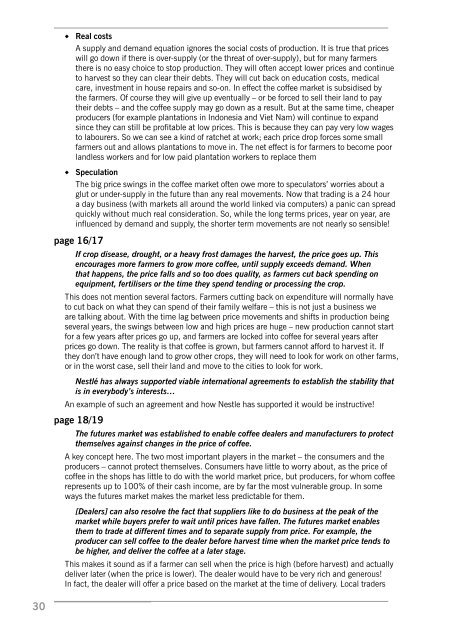Cost of coffee.indd - RISC
Cost of coffee.indd - RISC
Cost of coffee.indd - RISC
You also want an ePaper? Increase the reach of your titles
YUMPU automatically turns print PDFs into web optimized ePapers that Google loves.
◆<br />
◆<br />
Real costs<br />
A supply and demand equation ignores the social costs <strong>of</strong> production. It is true that prices<br />
will go down if there is over-supply (or the threat <strong>of</strong> over-supply), but for many farmers<br />
there is no easy choice to stop production. They will <strong>of</strong>ten accept lower prices and continue<br />
to harvest so they can clear their debts. They will cut back on education costs, medical<br />
care, investment in house repairs and so-on. In effect the c<strong>of</strong>fee market is subsidised by<br />
the farmers. Of course they will give up eventually – or be forced to sell their land to pay<br />
their debts – and the c<strong>of</strong>fee supply may go down as a result. But at the same time, cheaper<br />
producers (for example plantations in Indonesia and Viet Nam) will continue to expand<br />
since they can still be pr<strong>of</strong>itable at low prices. This is because they can pay very low wages<br />
to labourers. So we can see a kind <strong>of</strong> ratchet at work; each price drop forces some small<br />
farmers out and allows plantations to move in. The net effect is for farmers to become poor<br />
landless workers and for low paid plantation workers to replace them<br />
Speculation<br />
The big price swings in the c<strong>of</strong>fee market <strong>of</strong>ten owe more to speculators’ worries about a<br />
glut or under-supply in the future than any real movements. Now that trading is a 24 hour<br />
a day business (with markets all around the world linked via computers) a panic can spread<br />
quickly without much real consideration. So, while the long terms prices, year on year, are<br />
influenced by demand and supply, the shorter term movements are not nearly so sensible!<br />
page 16/17<br />
If crop disease, drought, or a heavy frost damages the harvest, the price goes up. This<br />
encourages more farmers to grow more c<strong>of</strong>fee, until supply exceeds demand. When<br />
that happens, the price falls and so too does quality, as farmers cut back spending on<br />
equipment, fertilisers or the time they spend tending or processing the crop.<br />
This does not mention several factors. Farmers cutting back on expenditure will normally have<br />
to cut back on what they can spend <strong>of</strong> their family welfare – this is not just a business we<br />
are talking about. With the time lag between price movements and shifts in production being<br />
several years, the swings between low and high prices are huge – new production cannot start<br />
for a few years after prices go up, and farmers are locked into c<strong>of</strong>fee for several years after<br />
prices go down. The reality is that c<strong>of</strong>fee is grown, but farmers cannot afford to harvest it. If<br />
they don’t have enough land to grow other crops, they will need to look for work on other farms,<br />
or in the worst case, sell their land and move to the cities to look for work.<br />
Nestlé has always supported viable international agreements to establish the stability that<br />
is in everybody’s interests…<br />
An example <strong>of</strong> such an agreement and how Nestle has supported it would be instructive!<br />
page 18/19<br />
The futures market was established to enable c<strong>of</strong>fee dealers and manufacturers to protect<br />
themselves against changes in the price <strong>of</strong> c<strong>of</strong>fee.<br />
A key concept here. The two most important players in the market – the consumers and the<br />
producers – cannot protect themselves. Consumers have little to worry about, as the price <strong>of</strong><br />
c<strong>of</strong>fee in the shops has little to do with the world market price, but producers, for whom c<strong>of</strong>fee<br />
represents up to 100% <strong>of</strong> their cash income, are by far the most vulnerable group. In some<br />
ways the futures market makes the market less predictable for them.<br />
[Dealers] can also resolve the fact that suppliers like to do business at the peak <strong>of</strong> the<br />
market while buyers prefer to wait until prices have fallen. The futures market enables<br />
them to trade at different times and to separate supply from price. For example, the<br />
producer can sell c<strong>of</strong>fee to the dealer before harvest time when the market price tends to<br />
be higher, and deliver the c<strong>of</strong>fee at a later stage.<br />
This makes it sound as if a farmer can sell when the price is high (before harvest) and actually<br />
deliver later (when the price is lower). The dealer would have to be very rich and generous!<br />
In fact, the dealer will <strong>of</strong>fer a price based on the market at the time <strong>of</strong> delivery. Local traders<br />
30




